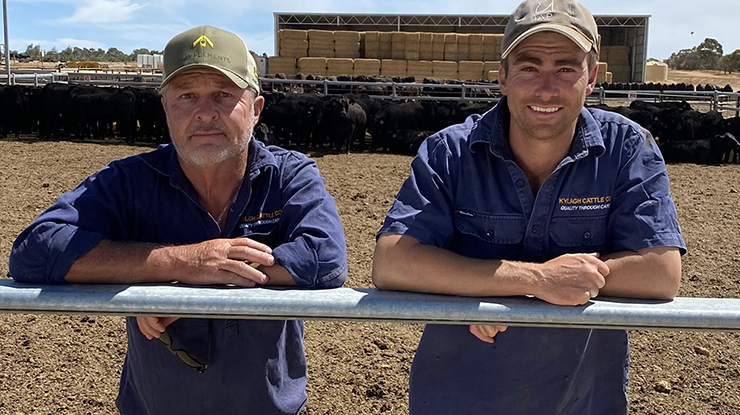Animal wellbeing focus delivers results
04 March 2024
 Ivan Rogers and his son Nick, with cattle using shade at Kylagh Feedlot. Kylagh was named Most Outstanding MSA Feedlot in WA at the 2021 MSA Excellence in Eating Quality Awards. Image: Ivan Rogers.
Ivan Rogers and his son Nick, with cattle using shade at Kylagh Feedlot. Kylagh was named Most Outstanding MSA Feedlot in WA at the 2021 MSA Excellence in Eating Quality Awards. Image: Ivan Rogers.
Kylagh Feedlot in WA is a testament to how best practice management to create a low-stress environment for cattle delivers results – with shade one of the key ingredients.
Kylagh is a leading Western Australian feedlot and early adopter of practices to improve feedlot cattle wellbeing and performance.
Across 110-day programs in summer, Kylagh Feedlot’s owner and general manager Ivan Rogers saw first-hand how shade benefited his cattle.
Recognising importance of animal wellbeing
Kylagh Feedlot has three pillars of priority when it comes to running their business: environment, animal wellbeing and people. Of these, Ivan said they have identified animal wellbeing as the most important investment.
“Shelter is a necessity for all walks of life. However, our lot holds predominantly black Angus and Waygu which are not very heat tolerant,” Ivan said.
Since implementing the shade, Ivan has observed changes to physical displays of heat load, including:
- less or no panting
- shade seeking behaviour on warmer days
- greater feed intake (increase of 0.13kg average daily gain)
- calmer behaviour.
Providing choice
Kylagh developed their shade and shelter infrastructure plan to give their livestock choice.
“While we were sure our cattle would seek shade, especially during summer, we found it was better to allow them the choice if they wanted to use our shade infrastructure or not,” Ivan said.
“During the summer, we saw the majority of our cattle making the most of the shade but there were still enough outliers who found the pen floor temperature to be cool enough to endorse our theory of providing the choice.”
Ivan said Kylagh Feedlot also allowed for choice by providing different types of shade.
“The style I have found most beneficial is a shade cloth supported by a six-metre-high steel infrastructure,” he said.
“Our shade cloths are about 10x25m, and we look to have enough of them to provide shade to 80 adult equivalents (AE) per pen which is at least 3m2 per head.
“In addition to our shade infrastructure, we’ve planted trees around our yards to provide a different form of shelter should our cattle seek it.
“This was done after surveying wind maps which showed our feed yard to be in a moderate to high wind environment, meaning trees would not have any detrimental impact of air flow.”
Supporting strategies
The feedlot is located 170km inland and experiences high levels of dry heat during summer, so Ivan has other strategies in his toolbox to reduce heat load in cattle.
“To help us prepare our cattle for extreme heat events, we keep a close eye on the predicted weather forecast through sources like the Bureau of Meteorology, which provide us with plenty of time to take action.
“It’s unusual for us to need to move our cattle from their pens, however we have a number of large yard areas which contain open water and we let our cattle move into these if the temperature calls for it.”
Other benefits
Ivan said providing shade to livestock had the added benefits of improving staff welfare and profit.
“Knowing our cattle have the resources to keep themselves cool during high temperatures reduces a lot of stress for us as their carers,” Ivan said.
“It's a big investment but it's worth it. Our cattle are now reaching their target weights earlier, leading to reduced feeding costs and time – we're likely to experience payback within 2–10 years.”
Ivan encouraged other producers and lot feeders to adapt their feedlots where needed, to match shade provision to their climatic requirements.
Enterprise snapshotKylagh Feedlot Augusta, Tammin and York, WA Area: 5,200ha Enterprise: 7,000-head feedlot (Angus, Wagyu and Angus/Waygu-cross) 1,500 Angus/Waygu breeders Rainfall: Augusta: 1,000mm Tammin and York: 320mm |
|
Lessons learnt
|


